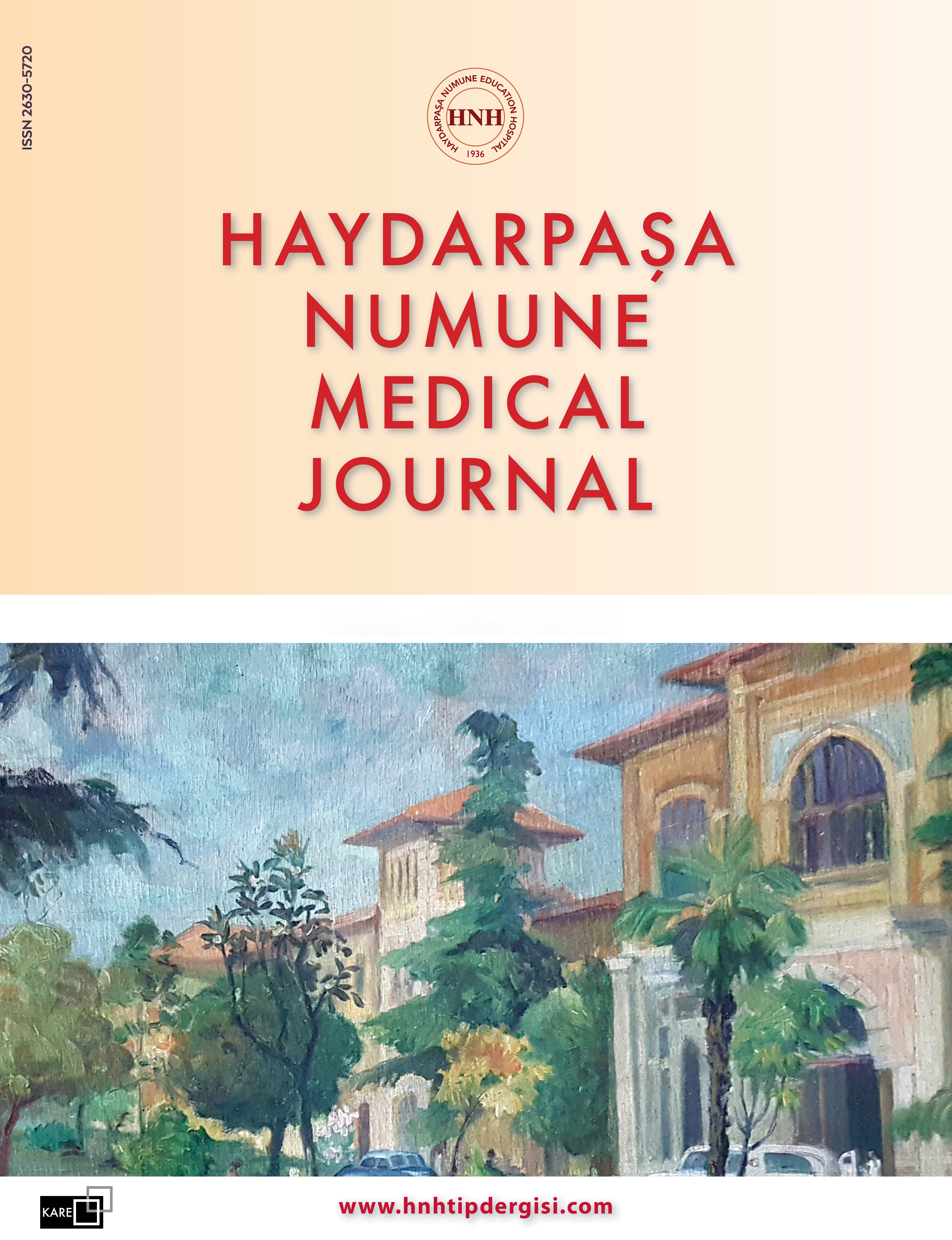Volume: 58 Issue: 3 - 2018
| RESEARCH ARTICLE | |
| 1. | The Evaluation of use of Complementary and Alternative Medicine Practices in the Treatment of Children with Chronic Neurological Disease Kürşat Bora Çarman, Sibel Laçinel Gürlevik, Emre Kaplan, Meltem Dinleyici, Coşkun Yarar, Didem Arslantaş doi: 10.14744/hnhj.2018.43265 Pages 117 - 121 INTRODUCTION: The aim of present study was to search the use of complementary and alternative medicine practices in children with chronic neurological disorders and associated factors METHODS: The prepared questionnaire was applied to parents of children admitted to the pediatric child neurology unit. RESULTS: A total of 832 parents participated in the search. Twenty-five per cent of parents stated that they had been using complementary and alternative medicine for the treatment of their children over the past year. It has been found that the incidence of complementary and alternative medicine increases with increasing maternal education level and income level of the family. The religious methods were most frequent modality. Only 5.8% of parents informed their doctors who managed follow-up and treatment. DISCUSSION AND CONCLUSION: One of every 4 children is using complementary and alternative medicine practices. Considering the possible side effects, we think that this question should be asked during routine visits to the outpatient clinic and pediatricians. |
| 2. | Correlation of Systemic Immune-Inflammation Index and Neutrophil-to-Lymphocyte Ratio with Histopathological Findings in Patients with Tongue Cancer İldem Deveci, Mehmet Sürmeli doi: 10.14744/hnhj.2018.96268 Pages 122 - 127 INTRODUCTION: The aim of this study was to evaluate the correlation of the systemic immune-inflammation index (SII) and neutrophil-to-lymphocyte ratio (NLR) with histopathological findings in patients with tongue squamous cell carcinoma (SCC). METHODS: 33 patients with tongue SCC were enrolled. The SII (NxP/L) based on neutrophil (N), lymphocyte (L), and platelet (P) counts was used as a biomarker. The results were compared with those of 34 healthy individuals. In addition, the correlation of NLR and SII with the presence of perineural and lymphovascular invasion, extranodal extension, and pathological differentiation degree was studied. RESULTS: Patients with tongue SCC had significantly higher NLR and SII than healthy subjects (p=0.027, p=0.023 respectively). Receiver operating characteristic curve analysis indicated optimal NLR and SII cut-off values to be 1.98 and 477.30, respectively. Comparisons of perineural invasion, lymphovascular invasion, and extranodal extension with SII were statistically significant (p=0.044, p=0.012, p=0.022). Nevertheless, NLR only correlated with extranodal extension (p=0.003). No significant correlation was observed between the pathological degree of tongue SCC and NLR and SII. DISCUSSION AND CONCLUSION: SII is a novel, inexpensive, and useful biomarker that has a predictive value in the disease progression of patients with tongue SCC. High levels of pretreatment SII indicate a probable high risk of perineural and/or lymphovascular invasion and extranodal extension. |
| 3. | Evaluation of Factors Affecting Adult Immunization Memet Taşkın Egici, Beray Gelmez Taş, Müfide Arzu Özkarafakılı, Güzin Zeren Öztürk doi: 10.14744/hnhj.2018.34713 Pages 128 - 132 INTRODUCTION: Vaccination is the most effective application in preventing from infections. In recent years, vaccination is still inadequate in adults despite the fact that there is a great deal of effort in childhood vaccination. We aimed to evaluate the vaccination status of adults and the factors that affected them. METHODS: In this descriptive study, a questionnaire consisting of 15 items exploring sociodemographic variables, the status of vacciniation and the factors influencing the vaccination was applied to adult individuals who admitted to family medicine clinics of Sisli Hamidiye Etfal Training and Research Hospital. The data were entered into the statistical program and analyzed. RESULTS: The average age of participants was 61.40±13.43. The proportion of participants who had adult vaccinations was 49.1% (n=108), average age of them were 60.68±13.47 and 66.7% were female. There was no significant relationship between age, sex, and education status of the adult vaccination's. The most important factor affecting the vaccination was physician 's recommendation (73%; n=86). the second factor was the effect of the media. Among the reasons for not having the vaccine, physician recommendation (70%; n=80) was found to be the first important factor also, the second factor was disbelief of need of vaccine. DISCUSSION AND CONCLUSION: In our study, it was determined that adult vaccination was inadequate and mostly influenza vaccine was used in adults. It was found that the physician's recommendation was the most common cause of the decision to get or not to get vaccinated. Since most frequently vaccinations were performed in family medicine units, physicians mainly family physicians recommendations will increase the rate of vaccination in adulthood. Thus, effort should be given to increase the awareness of physicians. We believe that raising the awareness of the community within the scope of health literacy will also positively affect adulthood vaccination. |
| 4. | Use of Processed Mammography Images as a Quality Control Tool Güven Bektemur, Nedim Muzoğlu, Melike Kaya Karaaslan, Mehmet Taşkın Egici, Özcan Gündoğdu doi: 10.14744/hnhj.2018.50480 Pages 133 - 136 INTRODUCTION: According to international quality control testing standards, image quality determination in mammography systems is based on measuring contrast-detail measurements with contrast-detail for mammography (CDMAM) phantom. It is therefore important to evaluate the CDMAM phantom images correctly. The purpose of this study is to compare the inverse image quality figure index (IQFinv) obtained by automatically evaluating digital CDMAM phantom images with Artinis software (version 2.2, CDCOM) for raw and processed images. METHODS: Digital phantom images were acquired in three different full-field digital mammography systems by using automatic exposure conditions (AEC). Five different phantom images were obtained from each mammography system as raw and processed as well as evaluated by the software. In addition, the IQFinv values of the systems were compared for mammography systems and the difference in between values was observed. RESULTS: The differences between the IQFinv values of raw and processed images were found to be 1.34%, 5.62%, and 6.7% for System A, B, and C, respectively. DISCUSSION AND CONCLUSION: It was observed that the differences between the IQFinv values of raw and processed images were almost negligible and the IQFinv values obtained from the raw images were slightly higher than the values obtained from the processed images. |
| 5. | Evaluation of Endometrial Changes with Transvaginal Power Doppler Ultrasound and Comparing Them with Endometrial Sampling in Breast Cancer Patients Using Tamoxifen Önder Sakin, Bülent Kars, Orhan Ünal, Engin Ersin Şimşek, Halim Ömer Kaşıkçı, Zehra Meltem Pirimoğlu, Ali Doğukan Anğın, Muzaffer Seyhan Çıkman doi: 10.14744/hnhj.2018.52244 Pages 137 - 141 INTRODUCTION: The most unwanted complication of tamoxifen is the development of endometrial carcinoma. In this study, we used transvaginal power Doppler ultrasound to determine endometrial vascular changes and compared them with the results of endometrial sampling. The diagnostic value of transvaginal power Doppler ultrasound was examined. METHODS: One hundred eleven breast cancer patients were included in the study. Endometrial, uterine, adnexal, and vascular evaluations were performed. Endometrial sampling was recommended to patients whose endometrial thickness was over 5 mm and was done in 73 patients. RESULTS: Group 1 (n=62) consisted of patients receiving tamoxifen and group 2 (n=49) consisted of patients who were not using tamoxifen. There were four endometrial polyps (5.5%) in the sample results in Group 2. Twenty patients (14 tamoxifen using and 6 non-tamoxifen using) had abnormal vascular changes on power Doppler examination but none of them had any malignant changes. There were abnormal vascular patterns on power Doppler examination in all of the patients detected with endometrial polyps. Three of them had benign measurable Doppler flow characteristics while one of them had non-measureable flows. All of the patients detected to have an endometrial polyp were pre-menopausal and did not use tamoxifen. DISCUSSION AND CONCLUSION: Transvaginal power Doppler ultrasound is an effective method for determining vascular changes in the endometrium. However, it is not enough for defining the lesion accurately in breast cancer patients. Moreover, it is not useful in determining which patients require invasive intervention. |
| 6. | Vestibular Evoked Myogenic Potential Responses in Patients with Systemic Lupus Erythematosus Ahmet Baki, Ahmet Adnan Cırık, Özlem Pehlivan, Muhammet Yıldız doi: 10.14744/hnhj.2018.14238 Pages 142 - 145 INTRODUCTION: To evaluate vestibular evoked myogenic potential (VEMP) test responses in patients with systemic lupus erythematosus (SLE). METHODS: Thirty patients who were followed up for SLE in rheumatology clinic were referred for the cVEMP test. A complete head and neck examination, neurotological examination, pure tone audiometry, and tympanogram test were performed for all patients. Seven patients with neurotological, acute and chronic otitis media, hearing the loss in pure audio audiometry, abnormal tympanogram, head and neck trauma, and disease and drug use history that could affect the vestibular system were excluded. Thirty healthy controls without medical therapy and systemic disease history that could affect the vestibular and auditory system and with normal pure tone audiometry and normal tympanogram were included in the study. Both the patient and healthy control groups were tested for cVEMP from 100 dB to 85 dB stimulation. The amplitude and latency values of cVEMP responses of the control group and SLE group were compared. RESULTS: No response was obtained in five patients in the SLE group, whereas all frequency responses were obtained in all the controls. There was a decrease in the amplitudes and latency prolongation in the SLE group compared to the control group. DISCUSSION AND CONCLUSION: Autoimmune diseases have been previously shown to contribute to the pathophysiology of endolymphatic hydrops. SLE is an autoimmune disease and can lead to saccular hydrops, which can be demonstrated by the cVEMP test. |
| 7. | Incidence of Solitary Rectal Ulcer Syndrome in Patients Undergoing Colonoscopy Ufuk Kutluana doi: 10.14744/hnhj.2018.29974 Pages 146 - 151 INTRODUCTION: This study aimed to investigate the incidence of solitary rectal ulcer syndrome in patients who underwent colonoscopy or sigmoidoscopy and were ultimately diagnosed with solitary rectal ulcer syndrome at our center. METHODS: Solitary rectal ulcer syndrome is a chronic benign condition that commonly presents with rectal bleeding, mucous discharge, and constipation. The diagnosis of this syndrome is based on clinical symptoms and endoscopic and histological features. The incidence rate of the syndrome has been noted to be 1 in 100.000 per year. RESULTS: We performed a retrospective analysis of patients who underwent colonoscopy or sigmoidoscopy by the same gastroenterologist at our center between 2012 and 2017. Data retrieved included demographic details, comorbidities, clinical presentations, laboratory, endoscopic, and histopathological findings, treatment procedures, and clinical outcomes. DISCUSSION AND CONCLUSION: The incidence rate of solitary rectal ulcer syndrome in patients who underwent colonoscopy was 0.68%. The most common symptoms included rectal bleeding, mucous discharge, and constipation. The incidence rate observed here was significantly higher than that in the previous report. Although the syndrome was described as a benign disease, it can result in serious complications including rectovaginal fistula, which was observed in one patient. |
| 8. | Clinicopathologic Results in Meniere Disease: Evaluation of 80 patients Mehmet Sürmeli, Ildem Deveci doi: 10.14744/hnhj.2018.75547 Pages 152 - 157 INTRODUCTION: Meniere's disease is the second most common disease among peripheral vestibular diseases. However, clinicopathology and treatment of Meniere's disease are not yet fully understood. In this study we aimed to investigate the relationship between the demographic features, audiological findings and treatment modalities of the Meniere's disease. METHODS: Demographic characteristics, additional diseases, pure audio audiometric test results and treatment modalities of 80 patients with Meniere's disease were compared retrospectively with statistical methods. RESULTS: The study involved 54 (67.5%) female, and 26 (32.5%) male patients with an average age of 47.5±12.0.54. Right ear was affected in 31 (38.8%) patients, left ear in 38 (47.5%) patients, and both ears in 11 (13.8%) patients. The most common comorbid diseases were diabetes mellitus (n=11) and hypothyroidism (n=11). The average hearing threshold values of 250-1000 Hz were 35.5±27.4 dBHL for the right ear, 41.4±30.5 dBHL for the left ear. The average threshold values of 2000-8000 Hz were 36.9±29.6 dBHL for the right ear and 45.7±31.4 dBHL for the left ear. There was no statistically significant difference between low and high frequencies in right and left ear (p=0.84, p=0.073). To fix vertigo 35 (43.8%) patients received medical treatment, 17 (21.2%) patients treated with transtympanic steroid ablation, and 28 (35.0%) patients treated with transtympanic gentamycin ablation. DISCUSSION AND CONCLUSION: The prolongation of diagnosis time in Meniere's disease induces additional impairment of high-frequency hearing and also causes difficulties in the diagnosis. |
| CASE REPORT | |
| 9. | A Rare Complication of Intravesical Bacillus Calmette Guérin Therapy: Local Progressive Pelvic Inflammation Serkan Akan, Aytaç Sahin, Ozgur Haki Yuksel, Ahmet Urkmez doi: 10.14744/hnhj.2018.24008 Pages 158 - 161 It has been proven that intravesical Bacillus CalmetteGuérin (BCG) therapy prevents the recurrence and progression of carcinoma in situ and of superficial bladder cancers, although local and systemic complications have been reported. However, careful attention should be given to the timing and management of this therapy because complications that may delay possible definitive treatment may also be seen. A case characterized with extensive inflammation, observed rarely after BCG therapy, involving pelvic organs and leads up to the internal abdomen and mesenteric area in the superior and levator muscle and prepubic area in inferior is presented here. |
| 10. | A Case of Varicella Complicated by Preseptal Cellulitis Hatice Dülek, Şule Nurşah Ayata, Narin Akıcı, Çiğdem Sağ, Zehra Esra Önal, Çağatay Nuhoğlu doi: 10.14744/hnhj.2018.77487 Pages 162 - 164 Chickenpox is a contagious, but typically mild, childhood illness characterized by an itchy rash. It is caused by the varicella zoster virus, which can provide the basis for a secondary bacterial infection. In this report, the case of a 6-year-old boy with preseptal cellulitis as a complication of varicella is presented to emphasize the fact that the illness may lead to severe complications that may require hospitalization. |
| 11. | A Rare Complication of Percutaneous Nephrolithotomy: Cerebral Infarction and Hemianopsia Abdurrahman İnkaya, Ahmet Tahra, Resul Sobay, Uğur Boylu, Eyüp Veli Küçük doi: 10.14744/hnhj.2018.60252 Pages 165 - 167 Since its description in 1976, percutaneous nephrolithotomy (PNL) has become the most common surgical technique for the management of large and complex stones in the intrarenal collecting system. A wide variety of complications can be observed, including bleeding associated with this procedure, damage to neighboring tissues and organs, infection, positional injuries, thromboembolic events, and even death. Knowing and predicting the different complications can be useful in preventing, diagnosing and preventing complications. We aimed to present the management of cerebral infarction and hemianopsia after PNL to our clinic as a case report. |
| 12. | Intravenous Lipid Emulsion Therapy in a Case of Multiple Drug Intoxication: Case Report* Volkan Hancı, Serhan Bülent Yurtlu, Ufuk Elmas, Işıl Özkoçak Turan doi: 10.14744/hnhj.2018.72691 Pages 168 - 172 Intake of cardiovascular drugs is frequently observed among the patients brought to emergency departments with an intoxication clinic. In those patients who are treated for intoxication, actual therapy is mainly supportive in most of the cases if there isnt any special antidote for the agent. This case report is about a patient who intended to commit suicide with oral intake of metoprolol, perindopril, atorvastati and isosorbide monohydrate. Upon worsening of her general condition in spite of supportive therapy, she was given intravenous lipid therapy. In this manuscript, application of intravenous lipid therapy is presented in a patient who intended to commit suicide, She was unresponsive to supportive therapy after ingestion of multiple cardiovascular drugs including metoprolol, perindopril, isosorbide monohydrate and atorvastatin. |
















